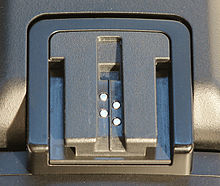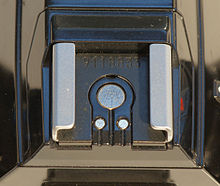- iISO flash shoe
-
iISO (intelligent ISO) flash shoe (aka "reversed" hotshoe) is the inofficial name for the proprietary accessory flash attachment and control interface used on Minolta cameras since the i-series introduced in 1988, and subsequently Konica-Minolta and later Sony α DSLRs and NEX-7. In order to speed up and enhance attachment, detachment and latching, it departs from the conventional circa-1913 mechanical design that is presently standardized as ISO 518:2006[1] and used by other camera systems, including Canon, Nikon, Pentax, Olympus, and Leica.
Contents
History
The mechanical design of the accessory shoe now common on most cameras dates back to 1913, when Oskar Barnack, the inventor of the Leica, devised it for attaching an accessory viewfinder.[2] By 1940's, with the addition of the central contact, the design became commonly used for attaching and triggering accessory flashes and known as the "hot-shoe". Prior to 1988, Minolta has used that familiar, common hot-shoe design, adding, just like the other makers, its own proprietary contacts for enhanced control.
In 1988, Minolta introduced the iISO flash shoe in its new i series of cameras. Reportedly conceived with the input from the late Herbert Keppler in 1987, the new Minolta patented design[3] featured a push-button latching mechanism, for the purpose of easier and faster flash attachment and removal and a more secure hold.
Design
Mechanical
The use of the button-operated latch, besides facilitating a quick, one-handed flash attachment and detachment, also eliminates the possibility of the flash gradually working itself loose and shifting in the shoe, which on camera systems using the ISO 518 hot-shoe can lead to certain contacts being broken, contacts with the wrong pins being made, or in extreme cases the flash sliding off the hot-shoe entirely.
- Attachment
As the flash slides onto the camera body, the sides of the T shaped flange on the body engage the lips of the rotated C shaped profile on the flash. When the flash is fully inserted, a spring-loaded latch on the flash locks into the indentation in the middle of the flash shoe. - Detachment
The user presses the unlock button on the flash body, which, by means of a lever or a wedge mechanism disengages the locking latch, enabling the user to slide off the flash from the camera body.
Electronic Contacts
Listed top-to-bottom (looking at the flash shoe socket as pictured above, or with the camera positioned with the lens pointing up):[4]
Pin Wire Analog Digital F3 black TTL OK Clock F2 white Ready Bidirectional serial data G blue Ground Ground F1 red Sync / trigger flash -- Variations
- Analog and digital control modes
Digital control mode is used if a contemporary flash is detected by the camera. Otherwise, to support basic triggers and legacy and low-end flashes, analog interface is used.[5] - Additional electronic contacts on Minolta 3000i/3700i
This low-end body omitted a built-in flash, and Minolta made available D-314i and D-316i compact and inexpensive flashes especially for it. These flashes relied on camera battery for power delivered via three additional pins on the hot shoe (+5V regulated flash electronics power, and unregulated power and ground wired to the camera's battery to charge the flash). No other camera body to-date has the additional contacts required to support the D-314i and D-316i flashes.[6]
Criticism
iISO hot shoe's introduction left few informed users indifferent - some photographers loved it, while others hated it. The sentiment revolves around these areas:
- Legacy support
During its 1988 introduction, the new Minolta iISO flash shoe presented an inconvenience to users with significant investment in the old, ISO 518 based Minolta flashes and accessories. The fact that Minolta chose to offset the new flash shoe introduction by three years from the 1985 MD-to-Minolta-A lens mount transition, as opposed to doing both concurrently, may have added insult to injury for some users. To soften the impact, Minolta had made available a FS-1100 (8825-670) adapter allowing to mount the old flashes and controllers on new bodies, and a FS-1200 (8825-680) to do the reverse. A custom-modified variant of the FS-1100 also featuring a PC sync terminal was made available by the Minolta service at request at least in Germany and the USA, this part was also mentioned in the Minolta USA FAQs under the unofficial name "FS-PC". - Interoperability across systems
It is possible to mount, say, a Canon flash directly on a Nikon body, and trigger it during the exposure. However, the ISO 518 hot-shoe standard does not govern electronic data transfer between the flash and the body[1] (e.g. for charge and exposure status, TTL metering, ratio, focal length, ISO exposure index, distance, pre-flash metering, modeling light, red-eye reduction burst, wireless control). Different camera makers' dedicated flash systems are, in fact, incompatible in terms of both the proprietary contact layout and the communication protocol. That said, many current wireless radio triggers for professional studio strobe systems remain a relevant real-world application of the basic ISO 518 hot-shoe design. Their use with Sony and Minolta DSLRs requires either the Minolta FS-1100 adapter, now discontinued, or the Sony FA-HS1AM adapter. There are also various 3rd party adapters such as the Seagull SC-5 or the Yongnuo YN-H3. There are however also wireless radio triggers for the iISO flash shoe available, like the PixelPawn TF-363 albeit at a bit higher price than ISO 518 hot-shoe triggers.
Resources
- Minolta/Konica Minolta/Sony Alpha flashes
- Flash Accessories
- Technical references
- Discovering the flash protocol
References
- ^ a b Photography -- Camera accessory shoes, with and without electrical contacts, for photoflash lamps and electronic photoflash units -- Specification, 2006 revision
- ^ "Speaking Frankly" PopPhoto blog by Herbert Keppler, January 10, 2007 post "Inside Straight: Shoe Fetish"
- ^ Matthias Paul: Article at Minolta-Forum detailing the Minolta hotshoe patents [1]
- ^ Matthias Paul: Article at Minolta-Forum on trigger circuit voltages, also describing the evolution of the Minolta hotshoe pinout over the decades [2]
- ^ Matthias Paul: Article at Minolta-Forum on the Minolta flash protocol - first known public description of parts of the digital data format [3]
- ^ Matthias Paul: Article at Minolta-Forum on various camera and accessory pinouts - first known public description of the various hotshoe signals, origin of naming conventions [4]
Categories:- Minolta
- Digital SLR cameras
- Sony cameras
- Sony Alpha DSLR cameras
- Attachment
Wikimedia Foundation. 2010.


